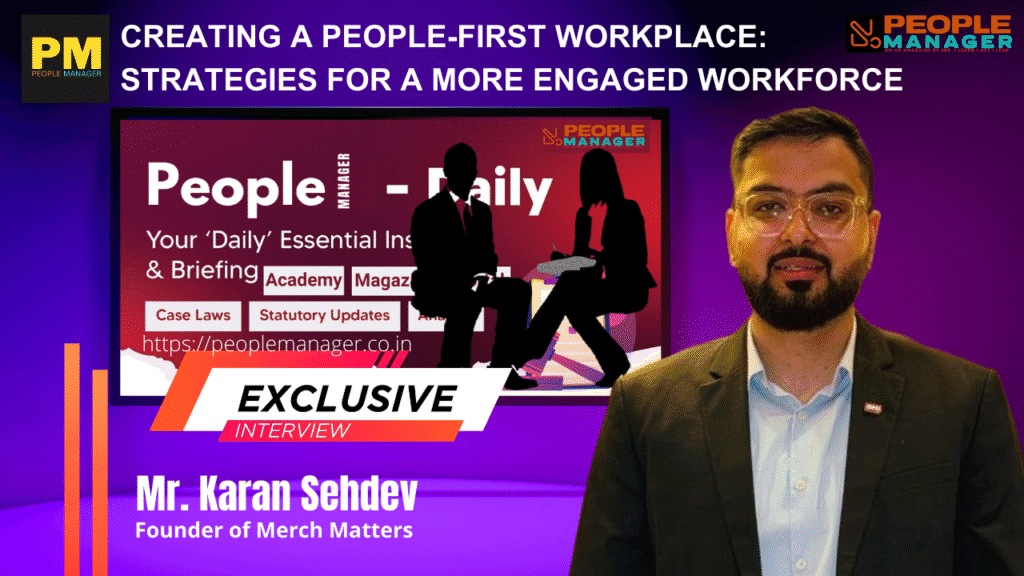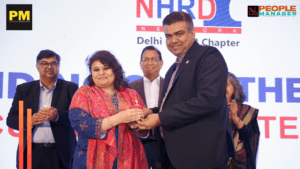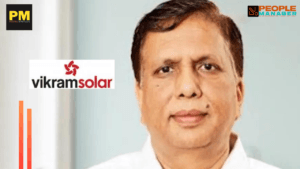Karan Sehdev on Creating a People-First Workplace: Strategies for a More Engaged Workforce
Building a thriving people-first workplace, is an ongoing journey centered on genuinely valuing and supporting employees through consistent actions, effective communication, and empathetic leadership. It necessitates a shift in mindset, prioritizing listening to employee needs, adapting to diverse cultural contexts, and leveraging technology thoughtfully to enhance human connections rather than replace them.

Creating a people-first workplace centers on small, consistent actions demonstrating that employees matter, fostering an environment of safety to speak up, appreciated feedback, and celebrated individualism. This approach prioritizes people over hierarchies and needs to be felt in everyday life, not just policy, enabling employees to feel like they belong. By listening more, being flexible, and showing genuine appreciation, organizations can significantly enhance employee engagement and well-being, with personalized well-being initiatives and consistent care being particularly impactful.
To understand the intricacies of establishing such a culture, the People Manager team engaged with Karan Sehdev, Founder & CEO of Merch Matters, to gain insights into his experience and strategies for cultivating a people-first environment. Mr. Sehdev’s perspective highlights that fostering this culture requires regular feedback mechanisms, clear communication, investment in learning and development, and support for mental well-being and work-life balance. Ultimately, a people-first approach contributes to business goals by creating a more engaged and motivated workforce, leading to improved retention and growth.
Karan Sehdev, a dynamic entrepreneur and Founder & CEO of Merch Matters, a company redefining corporate gifting and merchandising in India. His journey from Electronics and Communications Engineering to leading a multi-crore business is a testament to his resilience, innovation, and business acumen.
Q1. Defining the People-First Approach: In your experience, how do organizations worldwide define and implement a “people-first” workplace culture, and what fundamental principles underpin its success?
Ans.: A people-first workplace isn’t defined by massive gestures, it is made through small, consistent actions, reinforcing that employees matter to the organization. The ideal workplace is where an individual feels safe enough to speak up, where feedback is appreciated, and where individualism is celebrated rather than tolerated. Change starts with the leadership. If leaders are honest, approachable, and put their people first, this becomes the tone for everything else. This is about creating a flexible and supportive system, whether supporting people to work from home, giving them a day off for mental health, or simply checking in on them regularly.
At primary levels, a people-first culture prioritizes people over hierarchies. It is not a strategy; it is a way of life. It works only if it is felt in everyday life and not merely written into policy. The best workplaces allow people to feel like they belong instead of having to fit in.
Q2. Best Practices: What are some of the most effective strategies you’ve seen implemented across different industries and regions to enhance employee engagement and workplace well-being?
Ans.: The most powerful strategies happen to be the simplest ones: listening more, being flexible, and showing genuine appreciation. When employees feel that they are being heard and trusted, engagement improves on its own. The power of flexible work arrangements, mental wellness programs, and recognition of small wins should not be underestimated. Even more impactful is the personalization of well-being initiatives rather than the rollout of a one-size-fits-all program. It’s about being consistent and caring, not about making big gestures.
Q3. Process-Oriented Strategies: Can you walk us through the key processes organizations should adopt to ensure a structured and sustainable approach to fostering a people-first workplace?
Ans.: Cultivating a people-first culture is more than an afterthought to offer some benefits to employees. It is about creating a dynamic environment where employees feel heard, supported, and empowered every single day. The process begins with listening. Regular feedback mechanisms, such as anonymous surveys or open town halls, keep leadership informed about employee needs.
Clear communication is non-negotiable. When decisions are made, sharing the ‘why’ with people fosters a connection. The more organizations invest in learning and development, the stronger the signal that long-term growth is on the agenda, not just results. Providing mental well-being, flexibility, and work-life balance sustains motivation. The everyday structures—like how meetings are run, how leaders show themselves, or how achievements are celebrated—inform the employee experience. Build these intentionally, and the culture will take care of itself.
Q4. Cultural Adaptability in Global Workforces: How can multinational companies adapt people-first strategies to diverse cultural expectations while maintaining organizational cohesion and values?
Ans.: In a global environment, a universal people strategy does not work. Employee engagement and communication are based on cultural nuances, which can even influence how valued an employee feels. Hence, the most effective way is to start by building a strong and deep listening practice for local teams. What motivates employees in Southeast Asia might be entirely different from the motivators for teams in Europe or Africa, and that is all right. The critical step is to develop policies localized for the specific culture while keeping them anchored in a core set of universal values, such as respect, fairness, and transparency.
Balance is found in being flexible and not profaning culture. Truly, cohesion happens when people feel seen in their contexts and connected to an overarching purpose.
Q5. Leadership’s Role in Employee Engagement: What leadership behaviours and decision-making approaches have proven essential in creating and sustaining an engaged workforce?
Ans.: Today’s most impactful leaders lead with empathy and consistency. People want to be seen, not managed. Leaders who listen—truly listen—without rushing to respond are building better relationships across the board. Walk the talk about why something is done, especially in times of change. This is a way to create trust and lessen anxiety.
Another very powerful behavior is showing up, not just for the meetings but really for the moments that matter for the employee. Celebrating small wins, recognizing personal milestones, or just reaching out to employees during times of adversity—all contribute tremendously. Empowering employees is also extremely important. Keeping in an environment where the teams can make their decisions and draw from their own experiences without fear of failure naturally motivates them further. A people-first culture begins at the top, and leadership that is grounded, communicative, and approachable can be the differentiating factor between great workplaces and mediocre workplaces.
Q6. Technology and Innovation in Workplace Engagement: With the rise of AI and remote work, how can organizations leverage technology to enhance human-centered workplace practices without losing the personal connection?
Ans.: Technology can be a great enabler if used with care. AI or any remote collaboration tools could make processes more efficient and reduce employee burnout, giving individual employees the experiences they want. Having a relationship with these technologies should not replace relationships with other people. It is important to use technology in a way that amplifies rather than diminishes human relationships.
For instance, managers can use data insights to know when someone is at risk of feeling overwhelmed and can take action to prevent burnout. Remote working tools, together with actions such as virtual coffee catchups, feedback loops, and pulse surveys, keep teams connected despite distance. Space has to be preserved for spontaneous human contact. Flexibility, well-being, and communication are fine, but empathy and authenticity should not be sacrificed. That is when it becomes a bridge rather than a barrier.
Q7. Measuring Success and Employee Satisfaction: What are the most reliable methods and metrics to assess the effectiveness of a people-first strategy, and how should companies refine their approach based on employee feedback?
Ans.: The clearest indication of an effective people-first strategy? how employees feel, stay, and grow with the organization. Engagement and retention surveys, internal mobility, and absenteeism track valuable metrics however, mere numbers tell part of the story. The real insights come through open conversations. One-on-one check-ins, anonymous feedback forms, and even social sentiment gathered from internal platforms can give rich, qualitative data.
The best way to do it is consistently. To measure engagement once a year just doesn’t cut it, at least not in terms of any real reflection of sentiment; it just doesn’t register that kind of thing. Making changes based on what is heard and then clearly communicating those changes shows people that they can drive impact. This, over time, builds trust for continuous improvement. The best people-first strategies are not static; they evolve with the team.
Q8. Overcoming Resistance to Change: What are the biggest challenges companies face when transitioning to a people-first model, and how can HR leaders effectively address resistance from management or employees?
Ans.: Mindset is one of the major blocks. Some leaders confuse empathy with inefficiency, viewing flexibility as a potential roadblock to productivity. On the other hand, employees themselves may not always be convinced, asking if policies are actually being implemented and not merely part of some window-dressing gesture.
Establishing alignment and education over communication is key for HR leaders. Using data to build a business case that demonstrates how engagement translates into performance will be helpful. What drives change is the storytelling: success stories of the actual initiatives implemented, celebrating employee voices, and leading by them. Change is easier when modeled from the higher levels and reinforced with action, not just memos.
Asking for feedback during the rollout phase creates ownership and decreases resistance. Ultimately, people-first cultures thrive in situations where leadership is patient, transparent, and willing to take a long view. This change does not happen overnight, it’s a long-lasting one.
Q9. Future Trends in Workforce Engagement: Looking ahead, what emerging workplace trends do you predict will shape the next evolution of people-first strategies globally?
Ans.: Several trends determine the future of work, with people-first strategies changing alongside them. Personalization stands as one of the most potent trends. Purposeful work is yet another budding trend. An increasing number of professionals, more so within generations Y and Z, want to feel associated with something beyond profit. Corporations truly walking the talk with their values are in a strong position to attract and retain talent.
Mental wellness will remain an important agenda as burnout is now seen globally as an issue. In this regard, expect more holistic wellness interventions integrating physical, emotional, and financial health.
Last but not least, there shall be no extinction of hybrid work models. Future-ready people strategies will focus on building connected cultures across digital and in-person spaces, proving that flexibility and a sense of community can co-exist.
Q10. Practical Advice for HR Professionals: What are the top three actionable steps that HR leaders can take today to immediately foster a more engaged, people-first culture within their organizations?
Ans.: The first step is to open up a real dialogue. Start listening to anonymous surveys, team huddles, or one-on-one interpersonal conversations. Engagement is naturally drawn when there are voices heard; those become the blueprint for improvement.
Second, empower the manager. It’s along those lines that a people-first culture manifests in the direct way a manager interacts with their people. It could just ripple through the whole organization if you can equip them with empathy, communication, and even conflict resolution.
Third, get going immediately with even the tiniest of actions. That may mean acknowledging feedback, implementing some early quick wins, or introducing some pilot wellness programs. That’s how momentum builds trust.
It’s not through grand gestures but with step-by-step cultural changes, gradually, consistently, and with intent. When HR leaders act out empathy, responsiveness, and transparency, a whole transformation takes place in the workplace.
Conclusion:
In conclusion, building a thriving people-first workplace, as outlined by Karan Sehdev, is an ongoing journey centered on genuinely valuing and supporting employees through consistent actions, effective communication, and empathetic leadership. It necessitates a shift in mindset, prioritizing listening to employee needs, adapting to diverse cultural contexts, and leveraging technology thoughtfully to enhance human connections rather than replace them. Ultimately, the success of a people-first culture is reflected in how employees feel, stay, and grow within the organization, requiring continuous measurement, adaptation based on feedback, and a commitment to creating a dynamic and supportive environment where people feel they belong. For further insights into the evolving workplace paradigm, visit
- 𝐕𝐢𝐫 𝐁𝐡𝐚𝐫𝐚𝐭 𝐓𝐚𝐤𝐞𝐬 𝐎𝐧 𝐭𝐡𝐞 𝐌𝐚𝐧𝐝𝐚𝐭𝐞 𝐨𝐟 𝐒𝐞𝐜𝐫𝐞𝐭𝐚𝐫𝐲, 𝐍𝐇𝐑𝐃𝐍 𝐃𝐞𝐥𝐡𝐢 & 𝐍𝐂𝐑 𝐂𝐡𝐚𝐩𝐭𝐞𝐫 𝐟𝐨𝐫 𝟐𝟎𝟐𝟓–𝟐𝟎𝟐7 - December 6, 2025
- Suvarna Nikam On How AI-First Campaigns are Reinventing Employee Experience? - November 28, 2025
- How Siemens India is redefining workforce transformation by embedding HR at the strategic core ? - October 28, 2025








